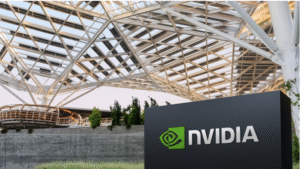IBM (NYSE:IBM) may no longer be a monopolist, but it is an emerging player in the lucrative AI, Cloud and Quantum spaces
![]() Nick Sundich, November 18, 2025
Nick Sundich, November 18, 2025
‘No one got fired for buying an IBM‘. Yes, that was an actual saying, sometimes in those exact words, otherwise the company’s name substituted for ‘Big Blue’. Of course, it was said more often in the 20th century than the 21st.
These days, IBM, also known as Big Blue, is not quite the big name it used to be. Scott Galloway asserted in his book ‘The Four’ that software graduates who end up at IBM are those who got to a final interview at Google, but didn’t get an offer.
True though that may be, with a US$284bn market cap (a figure that has doubled in 2 years) and US$60bn in each of the last 2 years, neither is it the case that this company is anywhere near dead.
At the same time, it is worth asking what does its future hold, and is the stock worth a buy? That’s what we’ll seek to answer in this article.
What are the best ASX Technology stocks to buy right now?
Check out our buy/sell tips
Who is IBM (NYSE:IBM)?
IBM (which stands for International Business Machines) is a multinational technology company, headquartered in Upstate New York, near the Connecticut border. The company produces hardware, software and it also provides consulting services.
The origins of the company trace back to 1911 when a company called C-T-R was incorporated to be a holding company for three technology companies at the time. What technologies you might ask? Things such as the mechanical time clock (employed by factories so workers could punch in and out of work) and the tabulating machine, that summarised information on punched cards.
Big Blue produced many technologies over the years under the ~40 year leadership of CEO Tom Watson. These include the magnetic stripe card, the hard disk drive, M1 Carbine rifles used in World War Two…but the first commercial stored-program computer was built in World War Two, and it kept on building up bigger and better computers and computer systems over the years, most notably the 360 system.
IBM struggled, but is still here
Many perceive that IBM had ‘lost ground’ to Microsoft in the 80s and 90s, a perception that is not entirely correct. It is more accurate to say that the computing world moved from high-performance mainframes to high-utility PCs. Microsoft was one manufacturer of PCs, but of course not the only one. At the same time, this enabled the market for computing services to grow and IBM was a beneficiary.
IBM still dominates mainframes and Microsoft still dominates PCs, both have higher enterprise values than 30 years ago, but it is companies like Google, Apple and Amazon that are at the absolute top as the world moved towards smartphones and Cloud services. You could argue IBM was more in decline in the 2010s as its revenue more than halved over the decade as the so-called FAANG stocks came to dominate the tech industry and global economy.
A new era awaiting?
IBM may have lost Round 1, but it is not entirely out of the AI and Cloud Services race just yet. The company bought software company Red Hat for US$34bn in 2019 and hired current CEO Arvind Krishna a year later. Revenues from Red Hat have doubled every single year since it was acquired as it has been the foundation of a hybrid cloud platform.
IBM now generates less than a quarter of its revenues from its traditional mainframe systems. 32% comes from consulting and 43% comes from software – the balance being financing. Its revenue has been >US$60bn over each of the last 2 years. Its revenue growth for the entire CY24 was modest, but has been sold in 2025 – 9% in Q3 of 2025. Free cash flow for 2024 was US$12.7bn and US$14bn is expected in 2025.
The company also has its eyes set on the future, looking to get into AI by launching watsonx, a multi-service platform with open-source libraries, models and datasets. Krisha has declared that AI will infuse ‘every single IBM product we have’.
A leader in Quantum Computing
Another growth opportunity is quantum computing, computing that relies on quantum mechanics to reach computing speeds faster than classical silicon-based computers, and thus accomplish more than their predecessors. Now, don’t get get too excited. There’s a long way to go before we see quantum computers become mainstream given several reasons including that they require sub-zero temperatures to operate and can make data errors. However, IBM is still looking to the future, unveiling a new chip last December that is made of 1,121 conducting qubits, the largest such chip ever released. IBM told investors it could produce quantum machines by 2033.
IBM is still a solid bet in the nearer term
Even while working on the technologies of future decades, the company is a growth opportunity in the nearer term, given its software and consulting businesses.
IBM’s “book of business” for generative AI reached >US$5 billion by the end of 2024 and reached US$7.5bn halfway through 2025. Its AI platform Watsonx generated US$1bn in less than a year and it has been expanded for enterprise AI deployment, orchestration and agents. Red Hat is continuing to pay off as growth has been strong in recent quarters. The infrastructure segment is going well too – IBM is launching new hardware (e.g., new mainframe generation, new server lines) to support enterprise workloads, especially where hybrid/edge/AI workloads are critical.
IBM is not afraid to spend big, having announced a US$150 billion investment in the U.S. over 5 years, including ~US$30 billion in R&D for mainframe and quantum computing. Another major step was the acquisition of Seek AI (an AI data platform) to bolster enterprise AI.
We mentioned the company guided to US$14bn in FCF, but it has also told investors to expect 5% revenue growth. Consensus estimates call for nearly 7% growth, to $67bn, then 4.5% growth in CY26 to surpass US$7bn. Strong EPS growth is expected from $6.43 to $9.09 in 2025, then to $10.07 in 2026.
Conclusion
IBM may no longer have a monopoly position, but it is a big player in emerging spaces (Cloud, AI and quantum) where there is unlikely to be one monopolist, but several big winners. As an underestimated company, but a very strong one nevertheless, investors willing to bet that it could be a winner may well be rewarded.
Blog Categories
Get Our Top 5 ASX Stocks for FY26
Recent Posts
NVIDIA’s Blackwell Chips Ignite Record Demand in Q3
NVIDIA’s Blackwell Surge Tech investors and growth-focused funds will be breathing a sigh of relief after NVIDIA (NASDAQ: NVDA) delivered…
REA Group (ASX:REA): Here’s why it succeeded over Domain Group at home, but hasn’t done that well abroad
REA Group (ASX:REA) is best known in Australia as the owner of realestate.com.au. For so long, the company (which is…
Here’s why companies undertake demergers and spinoffs, and some of the most famous deals in the last decade!
Investors often get themselves into frenzies over M&A deals (or just speculation of them), but demergers and spinoffs get less…



